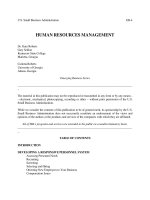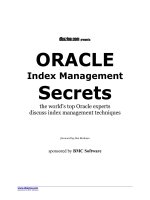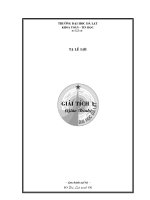Tài liệu E-Human Resource Management 1 pptx
Bạn đang xem bản rút gọn của tài liệu. Xem và tải ngay bản đầy đủ của tài liệu tại đây (842.35 KB, 9 trang )
e-Human Resources
Management:
Managing Knowledge People
Teresa Torres-Coronas
Universitat Rovira i Virgili, Spain
Mario Arias-Oliva
Universitat Rovira Virgili, Spain
Hershey • London • Melbourne • Singapore
IDEA GROUP PUBLISHING
Acquisitions Editor: Mehdi Khosrow-Pour
Senior Managing Editor: Jan Travers
Managing Editor: Amanda Appicello
Development Editor: Michele Rossi
Copy Editor: Maria Boyer
Typesetter: Jennifer Wetzel
Cover Design: Lisa Tosheff
Printed at: Yurchak Printing Inc.
Published in the United States of America by
Idea Group Publishing (an imprint of Idea Group Inc.)
701 E. Chocolate Avenue, Suite 200
Hershey PA 17033
Tel: 717-533-8845
Fax: 717-533-8661
E-mail:
Web site:
and in the United Kingdom by
Idea Group Publishing (an imprint of Idea Group Inc.)
3 Henrietta Street
Covent Garden
London WC2E 8LU
Tel: 44 20 7240 0856
Fax: 44 20 7379 3313
Web site:
Copyright © 2005 by Idea Group Inc. All rights reserved. No part of this book may be repro-
duced in any form or by any means, electronic or mechanical, including photocopying, without
written permission from the publisher.
Library of Congress Cataloging-in-Publication Data
e-Human resources management : managing knowledge people / Teresa Torres-Coronas,
Mario Arias-Oliva, editors.
p. cm.
Includes bibliographical references and index.
ISBN 1-59140-435-5 (h/c) ISBN 1-59140-436-3 (s/c) ISBN 1-59140-437-1 (eISBN)
1. Personnel management. 2. Information technology Management. 3. Knowledge
management. I. Torres-Coronas, Teresa, 1966- II. Arias-Oliva, Mario, 1968-
HF5549.E14 2005
658.3'00285'4678 dc22
2004016385
British Cataloguing in Publication Data
A Cataloguing in Publication record for this book is available from the British Library.
All work contributed to this book is new, previously-unpublished material. The views expressed in
this book are those of the authors, but not necessarily of the publisher.
As we were writing this preface, Madrid went through one of the
worst days in its history. This is why we want to dedicate this
book to the memory of those who are no longer with us, to the
memory of those who lost their lives in the bomb attack on a train
in Madrid on March 11, 2004. They were going to work, struggling
to balance work and life; they were part of our human capital;
they were inimitable, irreplaceable, and very special assets…they
should be here.
Dedication
E-Human Resources
Management:
Managing Knowledge People
Table of Contents
Preface vii
S
ECTION I: THE C UTTING-EDGE IN HRM
Chapter I.
Web-Based Organizing in Traditional Brick-and-Mortar Companies:
The Impact on HR 1
Jaap Paauwe, Erasmus University Rotterdam, The Netherlands
Elaine Farndale, Erasmus University Rotterdam, The Netherlands
Roger Williams, Erasmus University Rotterdam, The Netherlands
Chapter II.
Integrating Handheld Computer Technology into HR Research and
Practice 31
Scott A. Davies, Hogan Assessment Systems, USA
Robert F. Calderón, Caliber Associates, Inc., USA
Chapter III.
Social Network Mapping Software: New Frontiers in HRM 68
Mousumi Bhattacharya, Fairfield University, USA
Christopher Huntley, Fairfield University, USA
SECTION II: REDESIGNING HR ADMINISTRATIVE PROCESSES
Chapter IV.
E-Recruiting: Categories and Analysis of Fortune 100 Career
Web Sites 86
In Lee, Western Illinois University, USA
Chapter V.
Employee Self-Service HR Portal Case Study: Access, Content,
& Application 101
Andrew Stein, Victoria University, Australia
Paul Hawking, Victoria University, Australia
Chapter VI.
Human Resource Portals and the Protean Career: A Three-Factor
Model 122
Constant D. Beugré, Delaware State University, USA
S
ECTION III: E-LEARNING S TRATEGIES
Chapter VII.
Keeping Up with the Corporate University: Resources for HRM
Faculty and Practitioners 144
Pamela D. Sherer, Providence College, USA
Timothy Shea, University of Massachusetts Dartmouth, USA
Chapter VIII.
E-Learning Strategies of Italian Companies 171
Anna Comacchio, University of Ca’ Foscari, Italy
Annachiara Scapolan, University of Ca’ Foscari, Italy
SECTION IV: MANAGING IT AND ORGANIZATIONAL CHANGES
Chapter IX.
Is Organizational e-Democracy Inevitable? The Impact of
Information Technologies on Communication Effectiveness 206
Bernadette M. Watson, University of Queensland, Australia
Gavin M. Schwarz, University of New South Wales, Australia
Elizabeth Jones, Griffith University, Australia
Chapter X.
Managing and Practicing OD in an IT Environment: A Structured
Approach to Developing IT Project Teams 236
Joseph Logan, AstraZeneca Pharmaceuticals, USA
About the Authors 269
Index 276
Preface
vii
Aim of This Book
In 1998, a highly innovative film, Antz, directed by Eric Darnell and Tim Johnson,
was released. In the first scene of the movie, Ant Z 4195 is talking to his
psychoanalyst and saying:
“…and my job, don’t get me started on, cause it really annoys me…I feel
physically inadequate, I, I, my whole life I’ve never been able to lift 10
times my own body weight and when you get down to it, handling dirt
is…yuck, you know is not my idea of a rewarding career. It’s this whole
gung-ho super-organism thing that I, I, you know I can’t get, I try but I
can’t get it. I mean you know, what is it, I’m supposed to do everything
for the colony, and what about my needs, what about me? I mean I gotta
believe there’s someplace out there that’s better than this! Otherwise I’d
just curl up in a larva position and weep! The whole system out there just
makes me feel insignificant!”
Z 4195 is striving to reconcile his own individuality with the communal work
of the ant colony. Our unhappy and depressed ant is working for a traditional
hierarchical organization, where people are not treated as valuable assets and
IT systems are not yet implemented. Even worse, he is currently working for
an organization that may have neither examined people management prac-
tices, nor made a real connection between people and organizational perfor-
mance. While this behavior is still prevalent in many of today’s companies, we
are presenting a book about e-HRM, about how IT is changing traditional
HRM functions, about how e-HRM practices are implemented. Could this be
a paradox? We hope so, because as Junipier (1996) pointed out: “Paradox is
viii
an excellent creativity facilitator; it delivers a seismic jolt to dominant ideas,
themselves the most efficient suppressor of original thinking” (p. 19). We need
creative facilitators to develop the new e-HRM landscape.
The above presents one of our oldest concerns about managing people: Most
organizations are far from considering people as their most important asset.
They are also far from applying common sense practices such as those to be
found in Pfeffer’s book, The Human Equation (Harvard Business School
Press, 1996). These organizations are now entering the knowledge era, using
IT solutions to solve their old HRM problems in one out of 10 cases, and in an
uncreative way. Those in the world of HRM are being accused of living in an
ivory tower, managing the human side of their organizations in ways that lack
relevance in the new information era. The impetus for the HRM change comes
from recognition of recent developments in the HRM profession and a real-
ization that current practices do not reflect those changes, especially those
concerning IT strategies. The problem often results in policies, practices, and
strategies that may be outdated.
Organizations are progressively incorporating ITCs into their processes, using
different tools and solutions. These tools are applied in a wide variety of ways
(i.e., manufacturing resource planning, office automation, computer-supported
cooperative work, distributed teams, supply chain, enterprise-wide resource
planning, or virtual integration). The entry into service of the first high-capac-
ity transatlantic cable in 1956 and the launch of Sputnik in 1957 marked the
beginnings of the era of global information exchange. In 1956, for the first
time in history, the number of white-collar workers exceeded that of blue-
collar workers (Naisbitt, 1984).
The factor we would stress in this growth in TICs is not the increase in the
amount, capacity, or inter-connectivity of technology in organizations. The
strategic key lies in the organization’s ability to integrate these technologies
into their current business processes, and also in their ability to reorganize the
said processes (Orlikowski, 1999, p. 3). And this is what this book is all
about.
Content of This Book
e-HRM: Managing Knowledge People responds to the challenge of docu-
menting recognizable, innovative, and creative approaches to e-HRM. Its aim
is to define and carry forward the debate in a complex and versatile matter.









